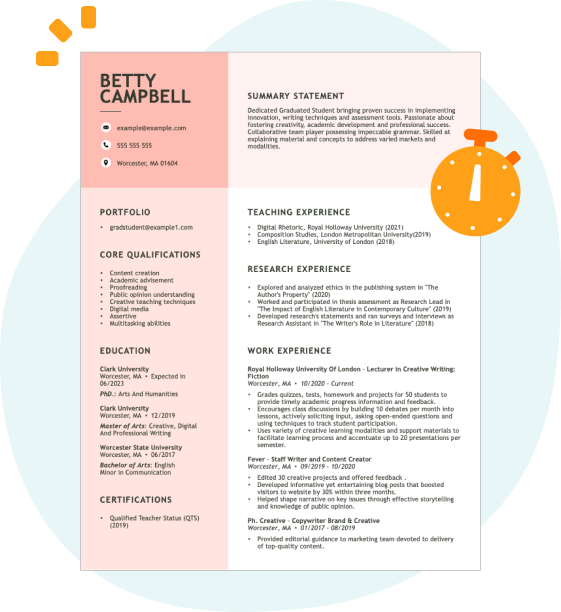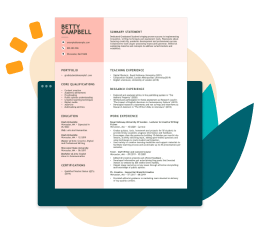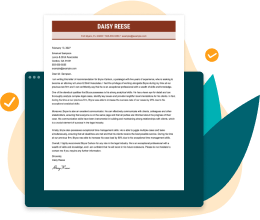Hard skills such as data entry, record management, and knowledge of healthcare regulations are essential for maintaining efficient administrative operations.
Popular Administrative Clerk Resume Examples
Check out our top administrative clerk resume examples that emphasize key skills like organization, attention to detail, and effective communication. These examples illustrate how to effectively showcase your qualifications to potential employers.
Are you ready to build your ideal resume? Our Resume Builder offers user-friendly templates specifically designed for administrative professionals, helping you make a great impression.
Entry-level administrative clerk resume
This entry-level resume for an administrative clerk effectively highlights the applicant's organizational skills and accomplishments from previous roles. It showcases their ability to improve office efficiency and streamline processes. New professionals in this field must demonstrate familiarity with administrative tasks, attention to detail, and a commitment to improving operational workflows despite having limited work experience.
Mid-career administrative clerk resume
This resume effectively highlights the applicant's qualifications by showcasing their successful process improvements and cost reductions. The progression from executive assistant to administrative clerk demonstrates an upward trajectory, emphasizing their readiness for increased responsibilities and leadership roles in office management.
Experienced administrative clerk resume
The work experience section illustrates the applicant's extensive background in office management, featuring significant achievements like reducing document processing time by 25% and coordinating cost savings of $5K annually. The clear bullet point format allows hiring managers to quickly assess accomplishments and skills.
Resume Template—Easy to Copy & Paste
Min Park
Portland, OR 97202
(555)555-5555
Min.Park@example.com
Professional Summary
Detail-oriented Administrative Clerk with 5 years of experience in office management, data entry, and workflow optimization. Proven success in enhancing accuracy by 25%, and achieving consistent 98% task completion rates. Adept at organizing schedules, coordinating teams, and delivering high-quality results.
Work History
Administrative Clerk
Midwest Solutions - Portland, OR
September 2022 - August 2025
- Processed 150+ documents weekly with 98% accuracy
- Improved data entry efficiency by 25% using automation tools
- Scheduled and coordinated office operations for 10+ departments
Office Assistant
ProVantage Group - Oakridge, OR
January 2020 - August 2022
- Maintained database of 5K+ client records with no errors
- Reduced supply costs by 18% through vendor negotiations
- Organized and documented 40+ monthly team meetings
Administrative Associate
Citywide Solutions Inc. - Portland, OR
January 2018 - December 2019
- Delivered error-free reports for 12+ monthly projects
- Streamlined filing system, increasing retrieval speed by 20%
- Assisted with payroll processing for 50+ employees
Skills
- Data Entry
- Office Administration
- Document Management
- Event Coordination
- Time Management
- Vendor Relations
- Database Maintenance
- Payroll Processing
Certifications
- Certified Administrative Professional (CAP) - International Association of Administrative Professionals
- Office Management Certification - Institute of Management
Education
Master's in Business Administration Business Administration
University of Illinois Champaign, Illinois
May 2018
Bachelor's in Management Management
Illinois State University Normal, Illinois
May 2016
Languages
- Spanish - Beginner (A1)
- French - Intermediate (B1)
- German - Beginner (A1)
How to Write an Administrative Clerk Resume Summary
Your resume summary is the first thing employers see, making it essential to create a compelling introduction that showcases your qualifications. As an administrative clerk, you should highlight your organizational skills, attention to detail, and ability to manage multiple tasks efficiently.
In this role, emphasize your skill in office software, strong communication skills, and experience with record-keeping. These attributes will set you apart and demonstrate your readiness for the job.
To guide you further, here are some resume summary examples that illustrate effective strategies and common pitfalls:
Weak resume summary
I am an experienced administrative clerk looking for a job where I can use my skills. I have done many tasks in my career and want to help the company succeed. A friendly work environment with chances to improve is what I desire. I believe I would be a great fit for your team if you hire me.
- Lacks specific details about relevant skills and experiences, making it hard to assess qualifications
- Overuses personal pronouns which dilute the message and make it sound less professional
- Emphasizes what the job seeker seeks rather than highlighting their contributions or value to potential employers
Strong resume summary
Detail-oriented administrative clerk with over 4 years of experience in managing office operations and supporting executive staff. Streamlined filing systems to increase efficiency by 30% and improved data accuracy through careful record-keeping practices. Proficient in MS Office Suite, database management, and customer service, ensuring seamless communication within departments.
- Begins with specific experience level and highlights relevant job functions
- Includes quantifiable achievements that illustrate impact on operational efficiency
- Showcases essential technical skills necessary for administrative roles
PRO TIP
Showcasing Your Work Experience
The work experience section is the cornerstone of your administrative clerk resume. Because this is section where you’ll provide the bulk of your content, good resume templates always ensure this section stands out.
This part should be organized in reverse-chronological order, highlighting your previous roles. Use bullet points to detail your key achievements and contributions in each position for clarity.
To further guide you, we will present a couple of examples that illustrate effective work history entries for administrative clerks. These examples will highlight what works well and what to avoid:
Administrative Clerk
ABC Corporation – Los Angeles, CA
- Answered phone calls and greeted visitors
- Managed schedules and organized files
- Performed basic data entry tasks
- Assisted other staff with daily responsibilities
- Lacks specific employment dates to show duration of experience
- Bullet points are overly simplistic and do not highlight accomplishments
- Focuses on routine tasks instead of showcasing skills or results
Administrative Clerk
Smith & Co. Inc. – Atlanta, GA
March 2020 - Present
- Manage daily office operations, ensuring efficient workflow and adherence to deadlines while supporting a team of 15 staff members
- Develop and implement an electronic filing system that reduced retrieval time by 40%, improving overall productivity
- Assist in preparing financial reports, contributing to a 20% reduction in monthly discrepancies through careful data entry and verification
- Uses strong action verbs at the beginning of each bullet point to clearly convey achievements
- Incorporates specific metrics that highlight the impact of the job seeker's contributions
- Demonstrates relevant administrative skills aligned with job expectations
While your resume summary and work experience are critical components, don’t overlook the importance of other sections. Each part plays a role in showcasing your skills and qualifications. For detailed advice on crafting an effective resume, be sure to check out how to write a resume in our comprehensive guide.
Top Skills to Include on Your Resume
A skills section is important for any resume as it allows you to quickly showcase your qualifications. It helps employers identify if you possess the skills that align with the job's requirements.
As an administrative clerk, highlight both hard and soft skills. A skills section that showcases this variety of skills will demonstrate you're a savvy candidate with strong interpersonal skills and work ethic.
Soft skills, including attention to detail, effective communication, and organizational abilities, play a key role in fostering teamwork and improving the patient experience in a healthcare setting.
Selecting the right resume skills is important as it aligns your qualifications with employer expectations and helps you navigate automated screening systems. Employers often look for specific competencies, and if your resume lacks these essential skills, it might not make it past the initial review.
To improve your chances, carefully examine job postings related to your desired role. These postings offer valuable insights into which resume skills are in demand, allowing you to tailor your resume accordingly and improve its visibility to both recruiters and ATS software.
PRO TIP
10 skills that appear on successful administrative clerk resumes
Highlighting essential skills in your resume can significantly attract the attention of recruiters looking for administrative clerks. For inspiration, out resume examples effectively showcase these skills and provide you with the advantage needed to land that interview.
Here are 10 valuable skills to consider incorporating into your resume if they align with your experience and job specifications:
Attention to detail
Time management
Communication
Problem-solving
Customer service orientation
Skill in Microsoft Office Suite
Data entry accuracy
Organizational abilities
Adaptability
Team collaboration
Based on analysis of 5,000+ administrative professional resumes from 2023-2024
Resume Format Examples
Choosing the right resume format is important for an administrative clerk. It clearly showcases relevant skills and experiences, helping to illustrate your professional journey effectively.
Functional
Focuses on skills rather than previous jobs
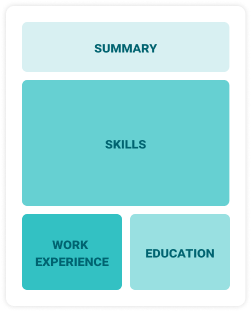
Best for:
Recent graduates and career changers with limited experience in administration
Combination
Balances skills and work history equally

Best for:
Mid-career professionals focused on demonstrating their skills and potential for growth
Chronological
Emphasizes work history in reverse order
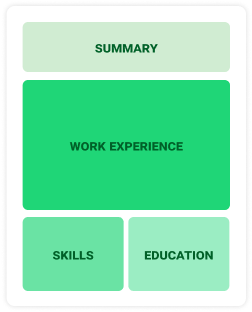
Best for:
Seasoned clerks excelling in team leadership and process optimization
Frequently Asked Questions
Should I include a cover letter with my administrative clerk resume?
Absolutely, including a cover letter can significantly improve your application. It allows you to showcase your personality and elaborate on your qualifications in a way that a resume cannot. If you're not sure how to write a cover letter, we have a great guide, plus our Cover Letter Generator can help you create one quickly and easily.
Can I use a resume if I’m applying internationally, or do I need a CV?
When applying for jobs abroad, use a CV instead of a resume as it’s often preferred by employers. To assist you in crafting a professional CV, we provide CV examples that detail proper formatting and writing techniques suitable for international standards. You can also explore our guide on how to write a CV to ensure your document meets expectations.
What soft skills are important for administrative clerks?
Soft skills like communication, organization, and problem-solving are essential for administrative clerks. These abilities include interpersonal skills that facilitate effective interactions with colleagues and clients, ensuring smooth operations and fostering a collaborative work environment that improves productivity.
I’m transitioning from another field. How should I highlight my experience?
When applying for administrative clerk positions, highlight your transferable skills such as organization, communication, and multitasking. These abilities show your readiness to excel in a new environment, even if you lack direct experience. Share specific achievements from prior roles that illustrate how you've effectively handled responsibilities similar to those required in this position.
How should I format a cover letter for a administrative clerk job?
When you format a cover letter for an administrative clerk role, begin with your contact details and a formal greeting. Include a compelling introduction early on, emphasizing skills that align with the job description. Tailor each section to meet the specific requirements of the position, and close with a strong call to action.
How do I add my resume to LinkedIn?
To add your resume to LinkedIn and increase its visibility, upload it directly to your profile or highlight key skills and achievements in the "About" and "Experience" sections. This approach helps recruiters easily find qualified administrative clerks, making you stand out in a competitive job market.


